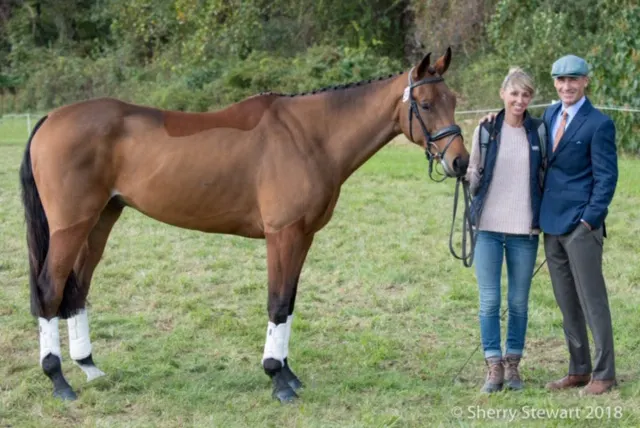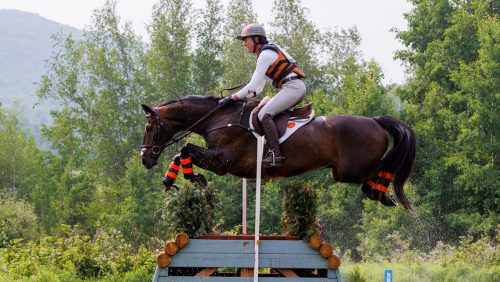I’ve talked about how a growth mindset can lead our human students to set more process-based goals, but what about our equine students? Can horses learn to have a growth mindset? According to neuropsychologist Dr. Stephen Peters and horseman Martin Black, the coauthors of Evidence-Based Horsemanship, “A horse’s ability to learn is largely dictated by his past experiences. Has your horse been able to explore, with or without a rider, circumstances to find a right answer, or has it been micromanaged and forced into a specific answer?”
Horses that have had the opportunity to explore solutions and make mistakes are the better learners, the pair says. These horses have “learned to learn.”

Horses, like people, can be trained to have a growth mindset and be taught how to learn, according to Matt Brown, shown here with his wife Cecily Clark and Big Berry. Sherry Stewart Photo
What Dr. Peters and Mr. Black are describing is exactly the same as having a growth mindset.
If we look at how teachers can help develop a growth mindset in their students, all we need to do is apply the same lessons to horses. The first thing to do is understand where the student is in their thinking. With human students that’s easy. Simply ask, “Show me how you got to this answer.” With horses it’s not that easy but just as simple.
Start by listening to your horse. Once you have a sense for where your horse is, in its mind, in its balance, in the training process, then you can start asking it the right questions to help it to learn. The importance is to focus primarily on the horse’s learning process while getting it to do what you want. Everything you teach your horse is not only teaching it a behavior, but also teaching it how to learn. Teaching the horse to learn will help it do what you want now and help it solve new problems in the future. Our responsibility to our horses is to not only impart knowledge, but to also teach them to have a growth mindset in order for them to have the tools to thrive in any challenging situation.
In order to learn, the horse can’t be worried about getting the answer right or wrong. Anxiety gets in the way of learning. For the trainer there can be no judgment on the horse’s process, just an effort to help the horse solve the problem. Like teaching humans, trainers can teach horses by:
• Praising effort over outcome. Reward every attempt small or large
• Using the horses’ setbacks as opportunities for learning
• Having true understanding be the goal of learning
• Showing interest in the horses’ process
• Showing that learning is a collaborative process by trying to understand why the horse is doing what it’s doing and asking the horse things like, “Good effort buddy, but let’s try this instead and see what you think.”
ADVERTISEMENT
Last year I ran into an issue with one of my 4-year-old off-track Thoroughbreds, Ben. Ben is cautious by nature, which can be a great thing when show jumping because it makes him very careful. But he can be very cautious when introduced to new things. I make a point with youngsters to not train with much pressure since they are just starting to understand the aids and are learning to trust their people.
I was hacking Ben around a cross-country field, and when approaching a bank I felt his anxiety come up. I spent some time walking around the bank until he was comfortable walking up to the bank and sniffing it. Once he was comfortable standing next to the bank I had him face the bank and put enough pressure on him to ask him to move his feet and think about the bank but not enough pressure to say, “Go over the bank.” This got him moving a bit from side to side, but he was still reluctant to go forward.Every time he started to think towards the bank I took all the pressure off and praised him, in a sense saying, “That’s the right direction.” This would give him a little break, and then I would get his feet moving again.
After a minute or two I could feel him starting to consider going off the bank. Then all of a sudden Ben decided to try and launched down the bank. I never increased the pressure, and actually since I was taking the pressure off every time he thought about the bank, I never closed my leg to tell him to “go.” He decided to try it on his own, so once I felt him start to go all I was doing was praising him. It is such a nice thing to feel a horse like this who is unsure of something find the confidence to try it. The confidence they gain is well worth the time it takes!
The question I wanted Ben to answer was the bank, but my main focus was:
• Keeping Ben relaxed, so he had room to think. Using just enough pressure to ask him to think about the question, but not enough pressure to escalate the situation.
• Praising him each time he was thinking in the right direction rather than waiting to praise once he jumped the bank (praising effort over outcome).
• Getting Ben to jump the bank was not my focus. My focus was asking him the question and allowing him the time to answer it. Giving Ben the opportunity to choose to jump the bank rather than forcing him to jump the bank gave him confidence in himself that, if continually developed, will lead him to become a reliable cross-country horse.
Some may say this sounds all well and good, but in the competition the horse has to jump because you said so, and it can’t take time to think about it. I would agree, but if you give the horse the time in training to really think and figure things out, then once you’re at the competition you won’t need to use much pressure because the horse already “gets it” and wants to do his job.
How do horses that have learned a growth mindset behave compared to horses trained with a more fixed mindset? Horses with a growth mindset are relaxed because they trust their rider, understand how to look for the right answer, and the rider, by working with not against the horses’ personality, has cultivated confidence within the horse. These horses don’t fear new experiences. While they might get anxious at times, they willingly engage with new things/tasks. They work with instead of against their rider. They enjoy being given the responsibility to answer tough questions.
ADVERTISEMENT
Horses that have been trained with a more fixed mindset hold a lot more anxiety because they don’t understand what’s expected of them. They may submit to their rider but do not willingly make an effort to answer new questions. They fear new situations because they don’t trust their rider or the situation. They are flightier in general, or aggressive depending on the horse’s personality, because they are unsure.
David O’Connor has said you can’t force a horse to compete at the upper levels of eventing. They have to want to do it. How do we produce that desire in horses? How do we get horses to want to answer tough questions? How do we get horses to be comfortable in unknown situations? I think the answer lies in approaching horses from a growth mindset and teaching them how to have a growth mindset just like how we would approach our human students.
Through my own struggles with a fixed mindset I’ve learned first hand that focusing too much on the outcome and thinking that our abilities and personalities are fixed can lead to a loss of motivation and even depression. As teachers, coaches and horse trainers we have a responsibility to help our students, equine and human alike, toward a growth mindset in order to open the door for them that leads to their greatest potential.
Here are some reminders of what we can do to help foster a growth mindset within our human and horse students:
• Praising effort over outcome
• Teaching our human students what it means to have a fixed or growth mindset
• Teach students to use setbacks as opportunities for learning
• Have true understanding be the goal of learning
• Showing interest in the students’ process
• Making learning be collaborative
• Focus on learning and teaching, not judging
• Teach students about goal setting and how to set process goals
• And always have patience. It’s a process. Trust it.
In the fourth part to this series I will talk about how the same issues with mindset and goal setting can adversely affect teams, from your personal barn team to the high performance teams.
If you found any of the ideas in this article helpful here are some books that have helped me:
“The Only Way To Win” by Jim Loehr
“True Horsemanship Through Feel” by Leslie Desmond and Bill Dorrance
“Think Harmony With Horses” by Ray Hunt
“Horses Never Lie” by Mark Rashid
“Chop Wood Carry Water” by Joshua Medcalf
“Mindset” by Carol Dweck
“Pound The Stone” by Joshua Medcalf
“Burn Your Goals” by Joshua Medcalf and Jamie Gilbert
“The Obstacle Is The Way” by Ryan Holiday
“The Essential Wooden” by Steve Jamison
“Coach Wooden’s Pyramid Of Success” by Jim Harrick and John Wooden
“Start With Why” by Simon Sinek














